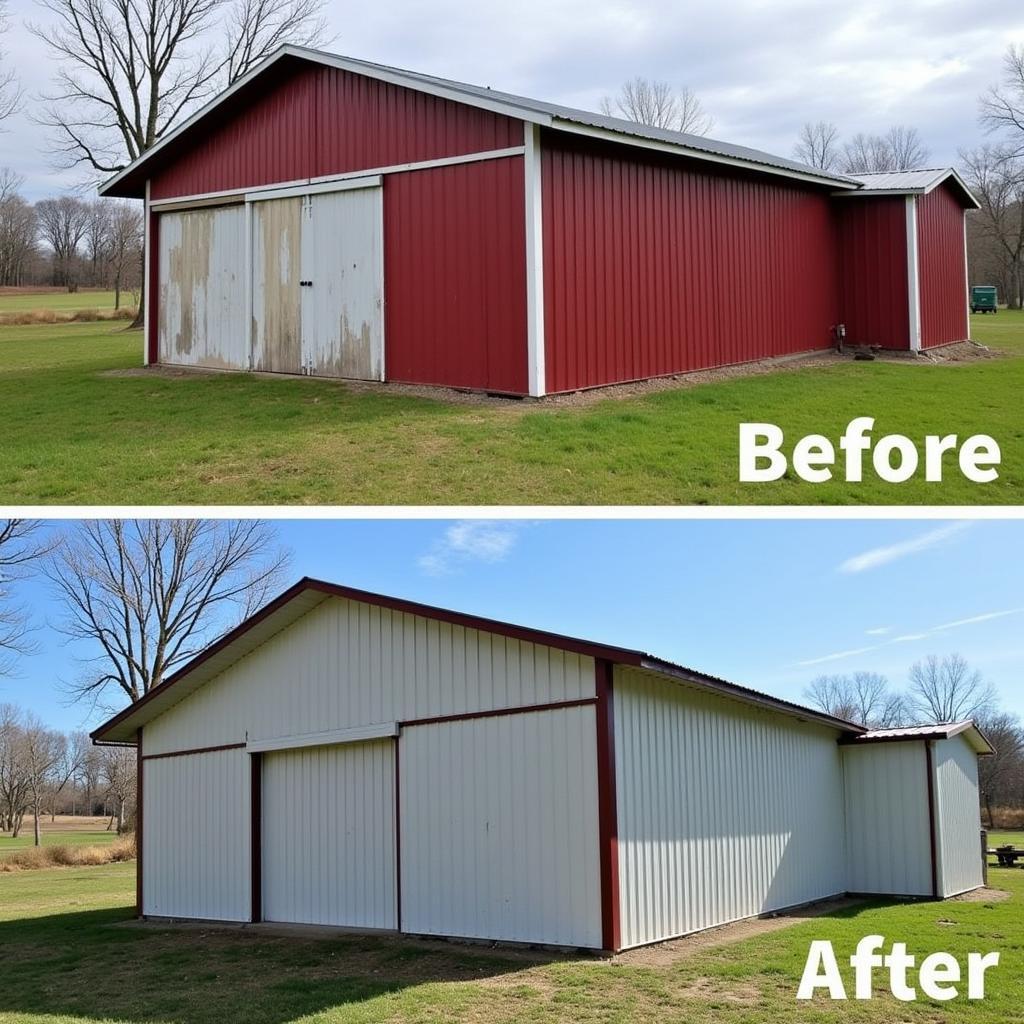Picking the right Horse Barn Colors is more than just an aesthetic choice. It impacts the barn’s functionality, your horses’ well-being, and the overall aesthetic of your property. From classic red to modern grays, understanding the psychology of color and its practical implications is key to making the best decision for your equine haven.
The Psychology of Horse Barn Colors
Color can profoundly influence both humans and animals. For humans, certain colors evoke specific feelings and associations. A calming blue might create a sense of tranquility, while a vibrant green can symbolize nature and growth. Similarly, horses, although they don’t perceive color in the same way we do, can still be affected by the brightness and intensity of different hues. Darker colors can absorb more heat, potentially making the barn warmer in the summer. Lighter colors reflect light, helping to keep the barn cooler. Choosing the right color palette can contribute to a more harmonious and comfortable environment for both you and your horses. After all, your barn is more than just a structure; it’s a home.
Popular Horse Barn Colors and Their Meanings
Certain barn colors have become traditional favorites for a reason. Classic red barns, for example, are deeply rooted in American history, often associated with practicality and durability. The red paint was originally made using rust and linseed oil, which provided a protective coating for the wood. White barns, on the other hand, evoke a sense of cleanliness and order, reflecting light and potentially keeping the barn cooler in warmer climates. Let’s explore some popular horse barn color options:
- Red: A timeless classic, representing tradition, warmth, and visibility.
- White: Clean, bright, and reflective, creating a sense of spaciousness and coolness.
- Brown/Beige: Natural and earthy, blending seamlessly with the surrounding landscape.
- Green: Harmonious with nature, symbolizing growth and tranquility.
- Gray: Modern and sophisticated, offering a sleek and contemporary aesthetic.
Factors to Consider When Choosing Horse Barn Colors
Beyond aesthetics, several practical factors should influence your color choice. The barn’s location, climate, and surrounding landscape all play a role. A dark-colored barn in a hot, sunny climate might absorb too much heat, making the interior uncomfortable for your horses. Conversely, a light-colored barn in a colder climate could help reflect sunlight and retain some warmth. Consider your horse racing decor as well.
Climate Considerations
- Hot Climates: Opt for lighter, more reflective colors like white, beige, or light gray.
- Cold Climates: Darker colors like brown or deep green can help absorb heat.
Landscape Integration
- Rural Settings: Earthy tones like brown or green can blend seamlessly with the natural surroundings.
- More Developed Areas: Consider more modern colors like gray or even a muted blue.
“Choosing the right barn color is about more than just aesthetics,” says renowned equine architect, Sarah Miller. “It’s about creating a functional and harmonious space that benefits both the horses and their owners.”
Maintaining Your Chosen Horse Barn Color
Once you’ve chosen the perfect color, proper maintenance is crucial to preserving its vibrancy and protecting the barn’s structure. Regular cleaning, inspections for damage, and repainting when necessary will ensure your barn looks its best for years to come. Think about your horse decoration and how the color scheme complements it.
Cleaning Tips
- Regularly remove dirt and debris: This prevents staining and discoloration.
- Use a mild detergent and water solution: Harsh chemicals can damage the paint.
- Inspect for signs of mildew or mold: Address these issues promptly to prevent further damage.
 Maintaining Your Horse Barn Color
Maintaining Your Horse Barn Color
“A well-maintained barn is a testament to the owner’s dedication to their horses,” adds Sarah Miller. “It shows a commitment to creating a healthy and comfortable environment.” For instance, even if you have easy costumes for horses, a clean and well-maintained barn is still a necessity. Don’t forget to check out options for a horse head ornament to add a personalized touch to your barn. And if you’re planning a party, consider our selection of horse themed party supplies.
Conclusion
Choosing the right horse barn colors is a crucial decision that combines aesthetics, practicality, and equine well-being. By considering factors like climate, landscape, and the psychology of color, you can create a beautiful and functional space that enhances the lives of your horses and complements your property.
FAQ
- What is the most popular horse barn color? Red remains a timeless classic.
- What color barn is best for hot climates? Lighter colors like white or beige are ideal for reflecting sunlight.
- How can I maintain my barn’s color? Regular cleaning and inspections are essential.
- Does barn color affect horses? While horses don’t see color like humans, brightness and heat absorption can impact their comfort.
- What are some modern barn color options? Gray and muted blues are increasingly popular choices.
- How often should I repaint my barn? This depends on the climate and paint quality but generally every few years.
- Can I paint my barn any color? While most colors are acceptable, consider local regulations and HOA guidelines.
For any assistance, please contact us at Phone Number: 0772127271, Email: [email protected] or visit our address: QGM2+WX2, Vị Trung, Vị Thuỷ, Hậu Giang, Việt Nam. We have a 24/7 customer service team.